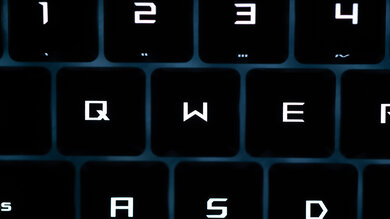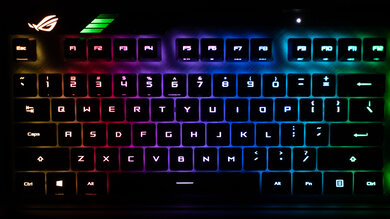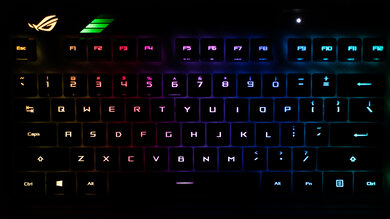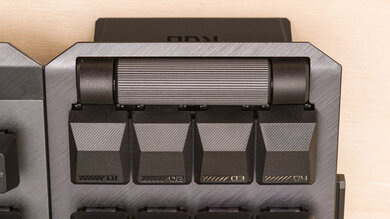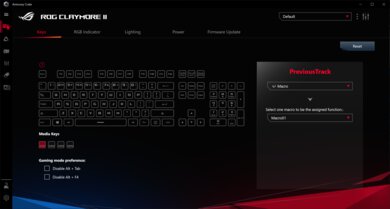The ASUS ROG Claymore II is a wireless full-size gaming keyboard with a modular numpad. Each side of the board has slots to let you position the numpad on the left or the right, depending on what suits you best. You can also remove it completely to use the board in a TKL size. All of its keys are macro-programmable through the Armoury Crate software, and it has a fast charging port and a USB passthrough. The board feels nice to type on, but the ROG RX Blue Optical Mechanical switches require some force to actuate, so they may feel a bit heavy to type on. However, it's also available with linear ROG RX Red Optical Mechanical Switches. While you can use the board wirelessly, you can only use it with its USB receiver, so you can't connect it to any Bluetooth-only devices.
Our Verdict
The ASUS ROG Claymore II is excellent for gaming. It has low latency, a low pre-travel distance, customizable RGB backlighting, and you can set macros to any key on the board. It feels well built, and it comes with a detachable plushy wrist rest. You can place its modular numpad on the left or right side of the board, and you can even remove it completely to turn the board into a TKL size. Unfortunately, the ROG RX Blue Optical Mechanical switches require some force to actuate, which may cause them to feel heavy.
-
Modular numpad.
-
Customizable RGB backlighting.
-
Low latency.
-
All keys are macro-programmable.
-
Numpad slots feel flimsy.
-
Clicky switches feel fairly heavy.
The ASUS ROG Claymore II is terrible for mobile or tablet use, but it isn't designed for this. While you can use the board wirelessly, you can only use it with its USB receiver, so you can't connect it to any Bluetooth-only devices. Also, even without the numpad, it's too tall and heavy to easily travel with.
-
Modular numpad.
-
Wireless via USB receiver.
-
No Bluetooth support.
-
Numpad slots feel flimsy.
-
Bulky and heavy compared to dedicated tablet boards.
The ASUS ROG Claymore II is good for office use. This sturdy-feeling board comes with a detachable, plushy wrist rest and one incline setting. You can use it wirelessly via its USB receiver, but since it doesn't support Bluetooth, you can't pair it with more than one device at a time. The board feels nice to type on, but the ROG RX Blue Optical Mechanical switches on our unit require some force to actuate, so they may feel a bit heavy to type on. Also, the switches are likely too loud for an office setting, but the board is also available with linear ROG RX Red Optical Mechanical switches that should be quieter.
-
Modular numpad.
-
Customizable RGB backlighting.
-
Wireless via USB receiver.
-
All keys are macro-programmable.
-
No Bluetooth support.
-
Numpad slots feel flimsy.
-
Clicky switches feel fairly heavy.
The ASUS ROG Claymore II is good for programming. It's a sturdy-feeling wireless model that feels nice to type on, but the ROG RX Blue Optical Mechanical switches on our unit require some force to actuate, so they may feel a bit heavy to type on. It comes with a detachable, plushy wrist rest and one incline setting. You can set macros to any key and customize the RGB backlighting. Also, you can choose to have the numpad on the left or right side of the board or remove it completely if you prefer a TKL size. Unfortunately, while you can use it wirelessly via its USB receiver, it doesn't support Bluetooth, so you can't pair it with more than one device at a time.
-
Modular numpad.
-
Customizable RGB backlighting.
-
Wireless via USB receiver.
-
All keys are macro-programmable.
-
No Bluetooth support.
-
Numpad slots feel flimsy.
-
Clicky switches feel fairly heavy.
The ASUS ROG Claymore II is inadequate for a home theater PC setup, but it isn't designed for this use. While you can use the board wirelessly, you can only use it with its USB receiver, so you can't connect it to any Bluetooth-only devices.
-
Modular numpad.
-
Customizable RGB backlighting.
-
Wireless via USB receiver.
-
No Bluetooth support.
-
Numpad slots feel flimsy.
-
No built-in trackpad.
- 8.8 Gaming
- 3.1 Mobile/Tablet
- 7.8 Office
- 7.9 Programming
- 5.7 Entertainment / HTPC
Changelog
- Updated Sep 10, 2021: Review published.
- Updated Sep 08, 2021: Early access published.
- Updated Sep 01, 2021: Our testers have started testing this product.
- Updated Aug 30, 2021: The product has arrived in our lab, and our testers will start evaluating it soon.
- Updated Aug 20, 2021: We've purchased the product and are waiting for it to arrive in our lab.
Check Price
Differences Between Sizes And Variants
We tested the ASUS ROG Claymore II with ROG RX Blue Optical Mechanical switches, but it's also available with ROG RX Red Optical Mechanical switches. It's available in black only. You can see our unit's label here.
Compared To Other Keyboards
The ASUS ROG Claymore II is a full-size gaming keyboard with a modular numpad that you can remove or place on either side of the board. It features ASUS' new proprietary optical-mechanical switches, which are available in a clicky or linear feel. Compared to other wireless gaming keyboards, it has a very low wired latency, but its receiver latency is higher than other options. However, along with its modular numpad, it has many interesting features that may please some gamers, like macro-programming, a volume control wheel, USB passthrough, and fast charging.
For other options, see our recommendations for the best mechanical keyboards, the best gaming keyboards, the best wireless keyboards.
The SteelSeries Apex Pro is a wired gaming board with an OLED screen, while the ASUS ROG Claymore II is a wireless gaming board with a modular numpad. The SteelSeries has a better build quality, and its customization software is available on macOS, while ASUS's software is only available on Windows. It has proprietary OmniPoint linear switches, which let you adjust the pre-travel distance needed to actuate a key, which affects the operating force. You can program its OLED screen to display almost anything, including GIFs, K/D ratios, or images. On the other hand, the ASUS is available with linear or clicky ROG RX Optical Mechanical switches, and you can position the numpad on either side of the board or remove it completely to have a TKL size.
The ASUS ROG Falchion and the ASUS ROG Claymore II are both wireless gaming keyboards, but the Falchion is a 65% compact board, while the Claymore II is a full-size board with a modular numpad. The Falchion is significantly smaller and comes with a cover case to protect its keys, making it a better option to travel. Its latency over both a wired and wireless connection is slightly lower. It's available with Cherry MX Red, Brown, Blue, and Speed Silver switches. Comparatively, the Claymore II comes with a plushy wrist rest, and it has more extra features thanks to its larger size, like a volume control wheel, a USB passthrough, and a numpad. It's available with linear and clicky ROG RX Optical Mechanical switches.
The Razer Huntsman V2 Analog and the ASUS ROG Claymore II are both full-size gaming keyboards, but the Razer is wired, and the ASUS is wireless. The ASUS has a modular numpad that you can place on either side of the board or remove it completely for a TKL size. Also, it has a volume control, a USB passthrough, four dedicated macro keys, a plushy wrist rest, and lower latency. You can use it wirelessly via its USB receiver, and it's available with linear and clicky ROG RX Optical Mechanical switches. On the other hand, the Razer has proprietary linear Razer Analog Optical switches, which let you use the keys like an analog joystick, and you can customize the pre-travel distance to your liking.
The Razer BlackWidow V3 Pro and the ASUS ROG Claymore II are both full-size wireless gaming keyboards, but the Razer is better overall. The Razer feels better built, and it has much lower latency, especially wirelessly. Also, it supports Bluetooth, and you can pair it with up to three devices at once. It's available with clicky Razer Green and linear Razer Yellow switches. On the other hand, the ASUS has a USB passthrough and a modular numpad, which you can put on either side of the board or remove completely to make it a TKL size. The ASUS is wireless, but it can connect through its USB receiver only. It's available with clicky ROG RX Blue Optical Mechanical switches and linear ROG RX Red Optical Mechanical switches.
The Razer Huntsman Mini is a wired 60% gaming keyboard, while ASUS ROG Claymore II is a wireless full-size gaming keyboard with a modular numpad. The Razer feels better built, and it's available with clicky Razer Optical Purple and linear Razer Optical Red switches. On the other hand, the ASUS has a plushy wrist rest, a lower wired latency, a volume control wheel, and a USB passthrough. Also, you can use it wirelessly via its USB receiver. Since its numpad is modular, you can use the board without it or even place it on either side. The ASUS is available with linear and clicky ROG RX Optical Mechanical switches.
The ASUS ROG Claymore II is a wireless full-size gaming keyboard, while the Razer Huntsman Tournament Edition is a wired TenKeyLess gaming keyboard. The ASUS has a modular numpad that you can place on either side of the board or remove it completely for a TKL size. Also, it has a volume control wheel, a USB passthrough, four dedicated macro keys, and a plushy wrist rest. You can use it wirelessly via its USB receiver, and it's available with linear and clicky ROG RX Optical Mechanical switches. On the other hand, the Razer has lower latency, and it's available with Razer Optical switches only.
The ASUS ROG Claymore II and the Corsair K100 RGB are both gaming keyboards, but the ASUS is wireless, and the Corsair is wired-only. The ASUS has a modular numpad that you can place on either side of the board or remove completely, and you can use the board wirelessly via its USB receiver. The ASUS is available with linear and clicky ROG RX Optical Mechanical switches. On the other hand, the Corsair has dedicated media keys, a multi-function wheel, and a lower latency. The Corsair is available with linear switches only, and you can choose between Cherry MX Speed and Corsair OPX switches.
The ASUS ROG Strix Scope TKL is a wired TKL board, while the ASUS ROG Claymore II is a wireless full-size board with a modular numpad. The Claymore II is a better choice for gaming, thanks to its much lower latency. Also, it has a volume control wheel, a USB passthrough, and a plushy wrist rest. You can place the numpad on the left or right side of the board or remove it completely for a TKL size. It's available with ROG RX Red Optical Mechanical switches and ROG RX Blue Optical Mechanical switches. On the other hand, the Strix Scope TKL is available with a variety of Cherry MX switches.
The HyperX Alloy FPS Pro is a wired TKL board, while the ASUS ROG Claymore II is wireless full-size model with a modular numpad that you can place on either side of the board or remove completely. The ASUS is a better gaming board thanks to its much lower latency, macro-programmable keys, passthrough, and Windows key lock. Also, it has customizable RGB backlighting, and you can use the board wired or wirelessly, while the HyperX has red backlighting, and you can only use it wired. The HyperX is only available in linear Cherry MX Red switches, while the ASUS is available with proprietary linear and clicky ROG RX Optical Mechanical switches.
The SteelSeries Apex 7 TKL is a wired TKL board, while the ASUS ROG Claymore II is a full-size wireless model. The SteelSeries has a small OLED screen that can display nearly anything you want, including GIFs, settings, and K/D ratios. It's available with SteelSeries Brown, Red, and Blue switches. There's also a full-size variant of this board if you prefer a numpad. On the other hand, the ASUS has a modular numpad that you can put on either side of the board, and you can also remove it if you occasionally want a TKL size. You can use the board wirelessly via its USB receiver, and its wired latency is lower than the SteelSeries. It's available with ROG RX Red Optical Mechanical and ROG RX Blue Optical Mechanical switches.
The ASUS ROG Claymore II is a wireless full-size gaming keyboard, while the Keychron K3 is a wireless 75% board for office use. The ASUS has macro-programmable keys, dedicated macro keys, customizable RGB backlighting, and a USB passthrough. Also, it has much lower latency, and it has a removable numpad that you can place on either side of the board or remove it completely. On the other hand, the Keychron has Bluetooth and can pair with up to three devices at once, and it comes with extra OS-specific keycaps and a switch to change the key bindings to match the OS you're using. The Keychron is available with low-profile Gateron switches, but some people may prefer standard-size switches like the ones found on the ASUS.
The ASUS ROG Claymore II and the HyperX Alloy Origins are both full-size gaming keyboards, but the ASUS is wireless while the HyperX is wired. The ASUS has more features, including a volume control wheel, a USB passthrough, four dedicated macro keys, and a modular numpad that you can place on either side of the board or remove it completely. It comes with a plushy wrist rest, and its wired latency is much lower than on the HyperX. The ASUS is available with clicky and linear ROG RX Optical Mechanical switches. On the other hand, the HyperX is available with linear HyperX Red switches only.
The ASUS ROG Claymore II and the Corsair STRAFE RGB MK.2 are both full-sized gaming models, but the ASUS can be used wired and wirelessly, while the Corsair is wired-only. The ASUS has a modular numpad that can be positioned on either side of the board or removed completely if you prefer a TKL size. It has a lower wired latency, and it comes with a plushier wrist-rest. It's available with proprietary linear and clicky ROG RX Optical Mechanical switches. On the other hand, the Corsair has dedicated media keys, and it's available with Cherry MX Red and Silent switches.
The ASUS ROG Claymore II and the Razer Huntsman are both full-size gaming keyboards, but the ASUS is wireless while the Razer is wired. Also, the ASUS has more features, including a volume control wheel, a USB passthrough, four dedicated macro keys, and a modular numpad that you can place on either side of the board or remove it completely for a TKL size. It comes with a plushy wrist rest, and its wired latency is lower than on the Razer. The ASUS is available with clicky and linear ROG RX Optical Mechanical switches. On the other hand, the Razer is available with Razer Optical switches only.
The Razer BlackWidow V3 and the ASUS ROG Claymore II are both full-size gaming keyboards, but the Razer is wired, and the ASUS is wireless. The Razer has a dedicated media key and marginally lower wired latency. It's available with clicky Razer Green and linear Razer Yellow switches. On the other hand, the ASUS has a USB passthrough and a modular Numpad, which you can put on either side of the board or remove completely to make the board a TKL size. Also, you can use the ASUS wirelessly via its USB receiver. It's available with clicky ROG RX Blue Optical Mechanical switches and linear ROG RX Red Optical Mechanical switches.
The ASUS ROG Claymore II and the Logitech G915 LIGHTSPEED are both wireless gaming keyboards. The Logitech has Bluetooth and can pair with two devices at once, while you can only use the ASUS wirelessly with its USB receiver. The Logitech has dedicated media keys, and its latency is lower than the ASUS', especially over a wireless connection. However, it's available with low-profile GL Tactile, Linear, and Clicky switches, which some people may not like. On the other hand, the ASUS has a USB passthrough, a modular numpad, and you can set macros to any key on the board, unlike the Logitech. The ASUS is available with linear and clicky ROG RX Optical Mechanical switches.
The ASUS ROG Claymore II and the Mountain Everest Max are both excellent modular gaming keyboards. They each come with detachable Numpads, meaning you can use them as TKL keyboards, but the wrist rest on the ASUS is full-size, so it sticks out from the side if you use it in TKL mode, but the Mountain comes with a TKL sized wrist rest. The ASUS is available with proprietary linear or clicky optical switches, while the Mountain is more versatile because it's hot-swappable, and it's sold with different Cherry MX switches. You can use the ASUS wirelessly, but only through its USB receiver, and if you use it wired, it has lower latency than the Mountain.
Test Results
The ASUS ROG Claymore II has a modular numpad that changes its size from a full-size to a TKL when removed. You can connect the numpad to either the left or the right side of the board.
Our review's test results for the width and weight show the measurements of the board with the numpad. Without the numpad, the board is 14.68" (37.3cm) wide and weighs 1.89 lbs (0.856 kg).
The wrist rest is full-size, so it fits perfectly with the numpad attached, but it will stick out if you use the keyboard in the TKL mode. If that bothers you, then check out a modular keyboard like the Mountain Everest Max.
The ASUS ROG Claymore II feels very well built. Its plastic body has very little flex, and it has a metal base plate with a brushed finish that helps keep the board feeling sturdy. The doubleshot ABS keycaps feel good, but they don't feel as durable as PBT keycaps. All keys feel stable, including the Shift and Enter keys, and only the Spacebar has some wobble to it. The rubber pads on the underside grip decently well, so the board is unlikely to move if you lean your hands against it. The incline feet are less grippy, but they should still hold well enough. There are slots on each side to easily attach and detach the modular numpad, but they have quite a bit of flex to them, so we recommend removing the numpad before transporting the keyboard anywhere. The plastic covers that hide the numpad slots also feel pretty cheap.
For some photos of the slots for the numpad, see below:
The ASUS ROG Claymore II has RGB backlighting with individually lit keys. It's great at color mixing, with no hints of colors when the lighting is set to white. There's a battery indicator at the top left next to the logo, but you can also customize this to be another RGB zone.
The ASUS ROG Claymore II's cable is very stiff and retains a lot of kinks from packaging. Both ends are USB-C, but the board comes with two USB-A adapters: a male to female adapter and a female to female adapter. The female to female adapter is a USB receiver extender that needs to be used with the cable.
You can use the ASUS ROG Claymore II wirelessly via its USB receiver. ASUS claims the battery lasts 144 hours with the backlighting off and 43 hours with the backlighting on at 100% brightness, but we don't test this. The USB receiver is a USB-C connection.
The ASUS ROG Claymore II has many extra features. All of the keys are macro-programmable, including the dedicated macro keys below the volume control wheel. There's a battery indicator next to the logo on the top left that you can program to match the rest of your RGB backlighting. Also, there's a fast charging port that doubles as a USB passthrough as well, and you can toggle between the two features with Fn + F12. Its numpad is modular, meaning that you can place it on the left or right side of the board, and you can even remove it completely if you prefer a TKL size. Note that the numpad uses power from the keyboard to function.
Our ASUS ROG Claymore II unit has clicky ROG RX Blue Optical Mechanical switches. They have a short pre-travel distance, which should help the board feel responsive, but typing may feel heavy because of the high operating force. If you prefer a linear feel, it's also available with ROG RX Red Optical Mechanical switches, but we haven't tested them.
The ASUS ROG Claymore II provides a great typing experience. The ABS keycaps have a slightly textured surface, and though they feel fairly good to type on, they're prone to shine from finger oils. All keys feel stable, including the Shift and Enter keys, and only the Spacebar has a bit of wobble to it. Thanks to the incline setting and the wrist rest, you shouldn't feel much fatigue typing on this keyboard. While the clicky ROG RX Blue Optical Mechanical switches feel a bit heavy, it shouldn't be enough to cause much finger fatigue, either. If you're left-handed or otherwise prefer to use the numpad with your left hand, you can easily connect it to that side.
The clicky ROG RX Blue Optical Mechanical switches on our ASUS ROG Claymore II unit are loud and are likely not suitable for a quiet office space. However, the board is available with linear ROG RX Red Optical Mechanical switches, which are quieter, but we haven't tested them.
The ASUS ROG Claymore II has incredibly low latency when used with its cable. While the latency is higher when using the USB receiver, it's still very good.
ASUS' Armoury Crate software has an easy-to-navigate interface. You can customize the RGB backlighting, set macros, remap keys, and save profiles to the ASUS ROG Claymore II's onboard memory.
The software is only available on Windows. However, all default keys still work on Linux, but the Scroll Lock and Pause keys don't work on macOS. While you can use the ASUS ROG Claymore II wirelessly, you can only use it with its USB receiver.
Comments
ASUS ROG Claymore II: Main Discussion
Let us know why you want us to review the product here, or encourage others to vote for this product.
This product has been merged with ASUS ROG Claymore II Wireless Modular Gaming Mecha. Follow the discussion here.
- 21010
Hey! thanks for reaching out, unfortunately we no longer have this keyboard which is the reason why we have not not tested it on our latest Test Benches. We apologize for the inconvenience!
- 21010
Could you measure the key release latency of this keyboard using method v1.3. I still do not find a single review measuring how fast Rx red and Rx blue can respond at key release. Thanks.






